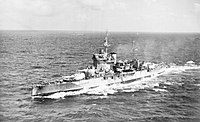Sir Charles Madden, 2nd Baronet
Admiral Sir Charles Madden Second World War
Mentioned in Despatches (2) |
|---|
Admiral Sir Charles Edward Madden, 2nd Baronet,
A recognized expert in gunnery, Madden helped in the introduction of
Following his retirement from the Royal Navy, Madden served as Vice
Early life and family
Charles Edward Madden was born on 15 June 1906, the son of Admiral of the Fleet Sir Charles Madden, for whom the baronetcy was created in 1919. His mother Constance was a daughter of Sir Charles Cayzer, 1st Baronet, the distinguished shipowner, and his aunt Gwendoline had married Admiral of the Fleet John Rushworth Jellicoe when he was a captain in 1902.
Pre-war service
Madden was educated at Sandroyd School then joined the Royal Navy as a naval cadet in 1920, attending the Royal Naval College, Osborne, and Royal Naval College, Dartmouth. On leaving Dartmouth in 1923 his father presented the prizes. He then went to sea for a cruise in the battleship Thunderer to complete his initial training.
In May 1924 Midshipman Madden was appointed to the battleship
In 1932, Lieutenant Madden joined the battleship
Newly promoted to lieutenant commander, Madden joined the cruiser Sussex as its gunnery officer in 1935. During the 1936–1939 Arab revolt in Palestine, Madden was involved in running the lightly armoured train (making it vulnerable to attack by Arab terrorists) from Haifa to Samak as well as protecting army encampments with naval field guns landed from the Sussex and light cruiser Arethusa.
Influenced by Kent’s gunnery officer, the future Admiral
Second World War

Madden was promoted to commander in 1939 and was part of the pre-commissioning crew for the new battleship King George V, which was followed by staff work involving British operations in the Baltic Sea and research on the applications of shipboard radar.
Commander Madden was appointed as the executive officer for the battleship
Madden was cited for official praise involving his damage control, fire-fighting, and casualty-relief efforts aboard the Warspite and the cruiser Orion during the Battle of Crete.[1] An eyewitness account described Madden as being "cool, calm and collected, at least on the outside" during the battle and its aftermath.[2] Madden also sustained a neck injury during a German bombing attack against the Warspite on 23 June 1941.[3]
Madden remained with the Warspite during her subsequent overhaul at the U.S.
Madden undertook a two-year stint as the deputy director of the gunnery division within the Admiralty with the rank of acting captain. In late 1944, he took command of the escort aircraft carrier
Cold War

After the war, Madden was confirmed in the rank of
- Admiral of the Fleet Andrew B. Cunningham, 1st Viscount of Hyndhope, from 1945 to 1946
- Admiral of the Fleet Sir John Cunningham, 1946–1947
In 1947, Captain Madden took command of the destroyer
Madden was promoted
Madden subsequently served as Flag Officer, Flotillas, Home (FOFH), the flag officer of destroyers and frigates in the Home Fleet from 1959 to 1961. In the Autumn of 1960, under his command, British naval forces led by the aircraft carriers
In 1963, Madden was appointed Commander-in-Chief
Retirement
After retiring, Madden served as Vice
Madden also continued his life-long interest in painting, and he participated in numerous collective and one-man exhibitions at such venues as the Plymouth Art Club.[6] He was best known for landscape paintings and seascapes having been partially taught to paint as a child by William L. Wyllie. This occurred while accompanying his father, Sir Charles Madden, 1st Baronet, on board Royal Naval vessels near the end of the First World War, his father having brought his son to sea in 1918 as a means to protect him from the Spanish flu. Both Wyllie and Madden were on the British vessels escorting the German High Seas Fleet to internment at Scapa Flow.
He and his wife were involved in numerous charitable activities. His memoirs were privately printed in 1988.
Following his death,
Personal life
Madden married Olive Robins in 1942 after a two-year engagement: she died in 1989.[1] They were survived by a daughter. Madden was succeeded in the baronetcy by his nephew, Peter John Madden, 3rd Baronet (1942–2006). Sir Peter was succeeded in turn in 2007 by his brother Charles Jonathan Madden, 4th Baronet (born 1949).[6]
Arms
|
References
- ^ a b c d "Obituary: Admiral Sir Charles Madden" by Dan van der Vat The Guardian (4 May 2001)
- ^ Bernard Hallas "My Life My War: Chapter 10a – The Catastrophe of Crete" WW2 People’s War – BBC
- ^ Bernard Hallas "My Life My War: Chapter 10b – The Catastrophe of Crete" WW2 People’s War – BBC
- ^ "No. 40499". The London Gazette (3rd supplement). 9 June 1955. p. 3301.
- Naval InstitutePress, 1999), p. 263 – 269
- ^ The Daily Telegraph(11 November 2001)
- ^ "Obituary: Admiral Sir Charles Madden" by Max Arthur. The Independent (London)
- Times of London
- ^ "Grants and Confirmations of Arms Vol. L". National Library of Ireland. p. 271. Retrieved 27 June 2022.
Bibliography
- Obituary by Dan van der Vat The Guardian (4 May 2001)
- Biographical Profile[The Daily Telegraph(11 November 2001)
- "Obituary: Admiral Sir Charles Madden" by Max Arthur. The Independent (London) (28 April 2001)[1]
- "Obituary" Times (London) [2]
- Bernard Hallas "My Life My War: Chapter 10a – The Catastrophe of Crete" WW2 People’s War – BBC [3] Archived 19 April 2013 at archive.today (31 May 2005)
- Bernard Hallas "My Life My War: Chapter 10b – The Catastrophe of Crete" WW2 People’s War – BBC [4] Archived 19 April 2013 at archive.today (31 May 2005)
